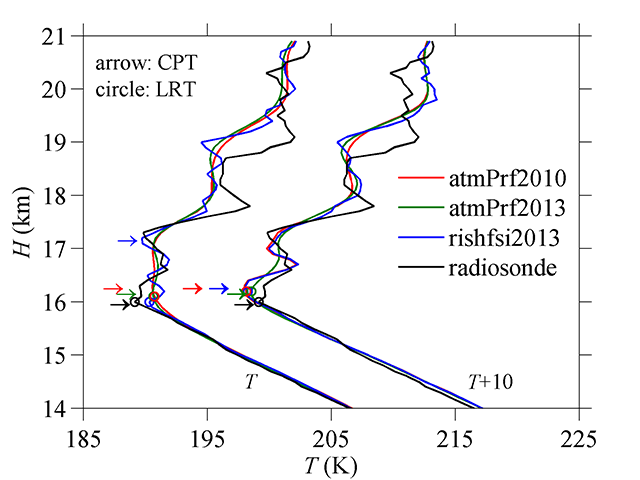|
|
|||||||||||||||||||||||||||||||||||||||
  |
|||||||||||||||||||||||||||||||||||||||
|
Paper Published: 2019/4/15 Comparison of three retrievals of COSMIC GPS radio occultation results in the tropical upper troposphere and lower stratosphereNoersomadi (Research Institute for Sustainable Humanosphere (RISH), Kyoto University, Kyoto), Toshitaka Tsuda (Research Institute for Sustainable Humanosphere (RISH), Kyoto University, Kyoto)
Comparison of three retrievals of COSMIC GPS radio occultation results in the tropical upper troposphere and lower stratosphere Combining geometrical optics (GO) and wave optics (WO), the COSMIC data analysis and archive center (CDAAC) retrieved two sets of dry atmosphere temperatures (T) from COSMIC GPS radio occultation (GPS-RO), which are called atmPrf2010 and atmPrf2013. In atmPrf2010, the sewing height between WO and GO varies between 10 and 20 km, but is fxed at 20 km for atmPrf2013. The height resolution of the atmPrf2010 depends on the sewing height, while the T profles by atmPrf2013 are smoothed over 500 m. We also derived T by applying WO throughout the troposphere and the stratosphere up to a 30-km altitude, which is called rishfsi2013. The three retrievals have diferent characteristics in the height resolution around the tropopause. Therefore, we aim to examine a possible discrepancy in the statistical results of the cold-point tropopause (CPT) and the lapse rate tropopause (LRT) among the three datasets, conducting their inter-comparisons as well as the comparison between GPS-RO and the simultaneous radiosonde dataset.
 Comparison of the T profles on December 17, 2011, between the radiosonde at Cengkareng (black line) and two nearby COSMIC GPS-RO by atmPrf2010 (red line), atmPrf2013 (green line) and rishfsi2013 (blue line), respectively. Arrows and circles indicate the CPT and the LRT altitude of each profle, respectively. Profles on the right are shifted by 10 K. We investigate the T variations in the upper troposphere and lower stratosphere (UTLS) over the tropics from October 1, 2011, to March 31, 2012, when radiosonde soundings were conducted as the CINDY-DYNAMO 2011 campaign. The mean T profles are consistent between atmPrf2010 and atmPrf2013, but rishfsi2013 results are colder (warmer) than the CDAAC retrievals below (above) the tropopause. The mean T diference between atmPrf2013 and atmPrf2010 is 0.17 K at the cold-point tropopause (CPT) and −0.38 K at the lapse rate tropopause (LRT). On the other hand, rishfsi2013 shows a colder T at CPT by −0.77 and −0.59 K relative to atmPrf2013 and atmPrf2010, respectively, and the warmer T by 0.60 and 0.20 K at LRT. During CINDY-DYNAMO, we found 134 radiosonde soundings that coincide with GPS-RO within ±3 h and are collocated within 200 km from GPS-RO. The mean T diference at CPT from the radiosondes is 0.32, 0.49 and −0.24 K for atmPrf2010, atmPrf2013 and rishfsi2013, respectively. Both atmPrf2013 and atmPrf2010 have a positive bias at CPT, while rishfsi2013 has a negative one. Similar comparisons at LRT are −0.45, −0.69 and −0.41 K, respectively, showing a negative bias for all GPS-RO retrievals. The results show that rishfsi2013 is consistent with the retrievals at CDAAC and the radiosondes. Due to its good height resolution, rishfsi2013 is useful for studies on mesoscale T perturbations in the UTLS. |
|||||||||||||||||||||||||||||||||||||||
|
